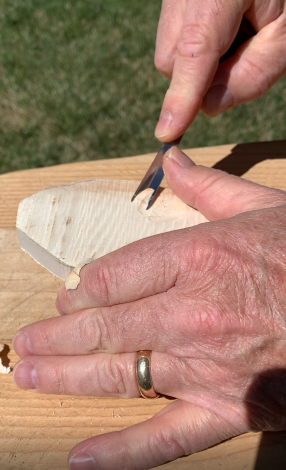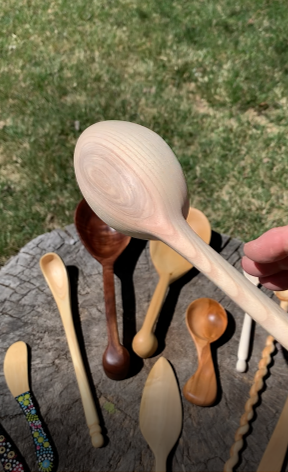I was talking with a friend just now about my previous blog post, where I had written how surprised I was to find that my hobby of spoon carving was helpful in opening my mind to a more creative space, one free of worry and tension. I wrote then about how I sometimes gain greater clarity of insightfulness about more important matters, even though I once thought I was carving simply as a diversion.
My friend aske me, "When you carve, do you pay intense attention to what you are doing or does your mind freely wander?"
I had not thought about that before. So, I began to try and notice what my mind is actually doing when I carve. And I realized that wood carving, for me, involves two very opposite states of mind.

The first is a mind frame of focused intensity. After all, a carving knife or grouge is razor sharp and I am pushing or pulling it into a piece of wood that is held, often, within fractions of an inch of the fingers of my other hand. That requires careful attention. I don't hear or see or think about anything else than what exactly I am doing with that tool and that pice of wood. Even then, I've been known to cut myself. I keep a box of Band-Aids at hand in my toolbox.
In some way that I am not sure how to describe, this requirement to focus intensely on one thing is a beneficial antidote to the sort of distracted thinking that consumes much of my work day. Email messages, calendar reminders, phone calls, zoom meetings, people who stop by my office, etc., all form a pulse of interruptions that defines the routine of much of my regular thinking. In business, we often call this multi-tasking. It's often described as a good capability to have. Maybe that's true, within limits. But for me, anyway, a respite from constant interruptions is very helpful to my ability to think. And spoon carving is a way for me to focus on just one thing without interruptions for an extended period of time.
Usually, when my schedule permits, I am good for 3 to 4 hours of intensely focused attention to carving. Then, I find I need a break. That's where another aspect of wood carving comes to my aid.
Some carvers, I know, like the look of a chisel finish on their spoons. I, too, find those attractive. But I am especially drawn to the beauty of wood that has been sanded to a very fine grit and then well-oiled. So, most of my spoons have a sanded finish. I sand the way I carve, by hand. I do not use power sanders. I typically finish my work to a level of 2,000 grit sandpaper.

I usually start with 80-grit and proceed through 12 or 13 ever-finer grits until I am done. That takes a long time. Often, I can carve a spoon from a hardwood blank in 3 to 4 hours. Then, I spend another 3 to 4 hours sanding it to the finish I want.
"Why bother?" You might ask. To many woodworkers, sanding is a tedious chore that simply must be done. To me, though, it is like therapy. When I am sanding--especially once I reach about 120-grit or higher--my mind is free to roam. When I carve, I think of nothing other than exactly what I am doing. When I sand, though, my mind roams every which way. I don't try to rein it in; I let it roam.
I now believe that this pendulum swing between both of these polar opposites--intense focus to mind wandering--is what makes spoon carving so good for me. I usually try to have several projects going at once, at various stages. That way, I can carve intently as long as I am energized by doing so. Then, when I am ready to wander, I turn to a project that is at the sanding stage. Often that is late in the afternoon or evening. I can step outside, sit on a picnic bench, and even sip a glass of wine while I sand. It's a great way to wind down after a few hours of intense mental focus. If only my regular work could be so restorative!